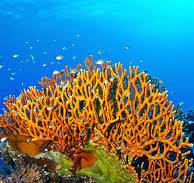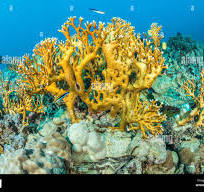Fire Coral: Hydrozoan Marvels of Shallow Reefs with Powerful Stings and Ecological Significance
Fire coral, scientifically known as Millepora, is a genus of marine organisms that belongs to the class Hydrozoa, closely related to jellyfish and other stinging cnidarians. Unlike true corals (class Anthozoa), fire corals are hydrozoans, characterized by their branching, calcareous skeletons and tiny polyps that are embedded in their calcareous skeleton. These organisms are found in tropical and subtropical waters around the world, typically in shallow reefs where they can thrive in warm, nutrient-rich environments.
Physical Characteristics
Fire corals derive their name from their appearance rather than their biological relationship to true corals. They have a distinctive bright orange or red coloration due to the presence of symbiotic algae called zooxanthellae, which live within their tissues and provide them with energy through photosynthesis. The colony structure of fire corals consists of small, branching structures that resemble plant coral, but are actually composed of tiny polyps.

Beautiful, but dangerous fire coral
Habitat and Distribution
Fire corals are primarily found in shallow waters, often forming dense colonies on rocks or dead coral substrates. They prefer areas with strong water currents, which help them to capture plankton and other small organisms for food. Their distribution ranges from the Indo-Pacific region to the Caribbean and Atlantic Ocean, where water temperatures are warm enough to support their growth.
Reproduction and Life Cycle
Like other cnidarians, fire corals reproduce both sexually and asexually. They can reproduce sexually by releasing eggs and sperm into the water, where fertilization occurs externally. Alternatively, they can reproduce asexually through a process called budding, where new polyps develop from existing ones to form new colonies. This combination of reproductive strategies allows fire corals to quickly colonize new areas and expand their populations under favorable conditions.
Ecological Role
Fire corals play an important ecological role in coral reef ecosystems. They provide habitat and shelter for numerous marine organisms, including fish, crustaceans, and other invertebrates. Their calcareous skeletons contribute to the overall structure of coral reefs, which are crucial for protecting coastlines from erosion and providing economic benefits through tourism and fisheries.
Interaction with Humans
While fire corals are not true corals and do not build reefs like their anthozoan counterparts, they are still capable of delivering a powerful sting. Their polyps contain nematocysts, specialized stinging cells that can cause painful welts and irritation if touched by divers or swimmers. This defensive mechanism helps protect fire corals from predators and accidental contact with larger organisms.

Fire coral
Conservation Status
Fire corals, like many coral species, face threats from climate change, ocean acidification, pollution, and overfishing. These factors can stress coral reefs and make them more susceptible to diseases and bleaching events. Conservation efforts aimed at reducing these stressors, promoting sustainable fishing practices, and establishing marine protected areas are crucial for ensuring the long-term survival of fire corals and their associated ecosystems.
In conclusion, fire corals are fascinating marine organisms that contribute to the biodiversity and structure of coral reef ecosystems worldwide. Despite their name and appearance, they are not true corals but hydrozoans with unique adaptations for survival in warm, nutrient-rich waters. Understanding and protecting fire corals is essential for preserving the health and resilience of coral reef ecosystems in the face of ongoing environmental challenges.
